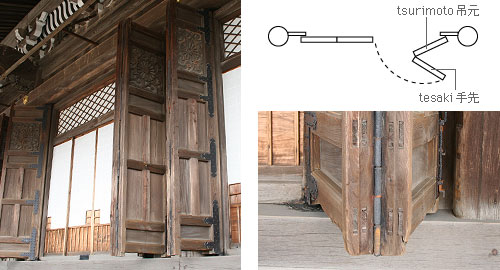|
||
 |
||
2 The leaf in a folding door that is the furthest from the leaf with the pivot hinges *jikuzuri 軸吊. It is also called the closing leaf. The pivot hinge leaf is the closest to the frame and is called tsurimoto 吊元. A two-leafed door with pivot hinges is called tesaki karado 手先唐戸 or tesaki for short. The stiles of the leaf that do not have pivot hinges are called tesakigamachi 手先框. See *karado 唐戸, *sangarado 桟唐戸.

Senshuuji
Nyoraidou 専修寺如来堂 (Mie)
3 The edges of the hinged doors on a storehouse *dozou 土蔵, that have stepped moldings attached. Two-stepped tesaki are called tesaki nijuu 手先二重 and 3-stepped tesaki are called tesaki sanjuu 手先三重.
(C)2001 Japanese Architecture and Art Net Users System. No reproduction or republication without written permission.
掲載のテキスト・写真・イラストなど、全てのコンテンツの無断複製・転載を禁じます。

